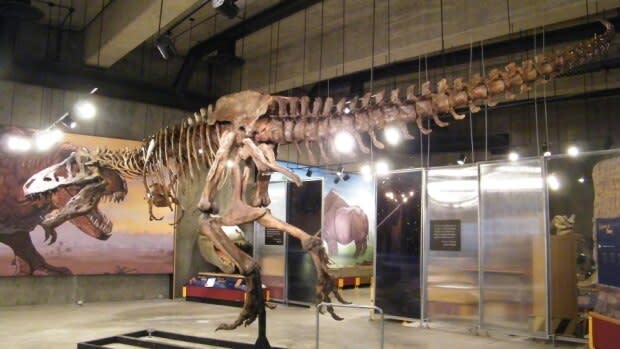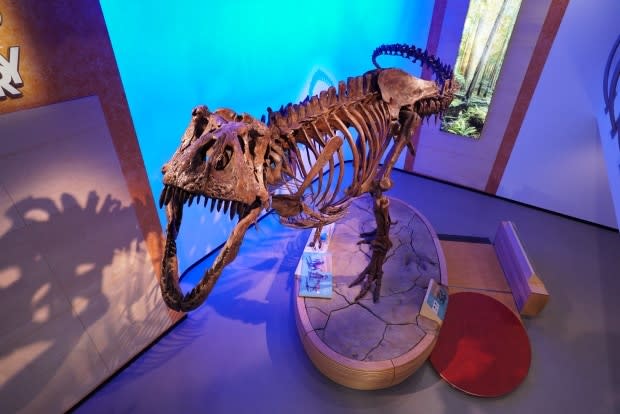Scotty goes to Scotland: Replica of world's largest T. Rex, discovered in Sask., part of touring exhibit
Scotty the T. Rex is once again roaming the Earth.
Or at least, a replica of Scotty is.
The replica of Scotty — the nickname for the world's largest Tyrannosaurus rex specimen, which was discovered in Eastend, Sask., back in 1991 — is part of an Australian Museum travelling exhibit called Tyrannosaurs — Meet the Family.
The Sydney-based museum's exhibit is currently at the National Museum of Scotland in Edinburgh.
"At this point Scotty is better traveled than I am," quipped Ryan McKellar, curator of paleontology at the Royal Saskatchewan Museum in Regina.
The exhibit, which highlights the family of tyrannosaurs and their history over 100 million years, began in 2015 at the Australian Museum. It has since gone to other museums in Australia and New Zealand, Iowa and North Carolina in the U.S., and to Canadian museums in Kitchener, Ont., and Halifax.
"And Scotty is the sort of centrepiece of that exhibit, because it is the biggest T. Rex specimen that's out there," said McKellar.

The replica that is part of the exhibit was made by Research Casting International (RCI), which has done replication work of larger skeletons like Scotty for the Royal Saskatchewan Museum.
McKellar said the museum has a licensing agreement with RCI that allows for Scotty clones to be made.
"There's a fairly large demand for that because Scotty is such a large T. Rex specimen," McKellar said. "It's one of the highlights of the RCI catalog."
The fossil was discovered in 1991 in Eastend, Sask. Excavation work began in 1994 and took six summers to complete. It took more than a decade to get all the rock off the bones and reassemble the skeleton.
It's estimated the dinosaur was 13 metres (almost 43 feet) long would have weighed 8,870 kilograms.
The first cast of Scotty appeared in the T. Rex Discovery Centre in Eastend in 2013 and another replica was unveiled at the RSM in 2019.
In addition to those, and the one touring with Australian Museum's exhibit, a fourth is at the National Museum of Nature and Science in Tokyo.
McKellar said once a museum decides on a pose, and designs and makes the fibreglass model, the actual replica can be assembled in the span of a day.

The Saskatchewan museum still has the original skeleton, which it continues to do research on.
McKellar said putting the real Scotty on display would not be feasible.
For one, only 65 per cent of the fossil was recovered, much of it in tiny pieces.
In addition, the real bones are just too heavy.
"A good example is the thigh bone on Scotty that weighs something in the neighborhood of 250 pounds, and it's fragile," McKellar said.
"[A replica] allows us to present to the public a more complete picture of the animals.… I think it makes it much easier for the public to envision what the animals look like and just how impressive they would have been."

Scotty isn't the only Saskatchewan fossil that goes abroad.
McKellar said other fossils are borrowed by international institutions each year for research purposes.
Other famous fossils include the only known example of a tyrannosaurus coprolite (fossil feces found in the same valley as Scotty), as well as a brontothere (a rhinoceros-like mammal that lived about 40 million years ago), and a wide range of marine reptiles.
Having Scotty replicas tramp around the world shines a spotlight on the work being done in Saskatchewan.
"This allows us to share the deep history of Saskatchewan with a much wider audience, and hopefully it draws people in to visit our province and see where the discoveries are being made," McKellar said.
"It's kind of exciting to see the international reach — that some of the research and exhibits work that we're doing here has led to some of these larger travelling exhibits."
The replica of Scotty is in Scotland until May. The Australian Museum exhibit will then travel to the Milwaukee Public Museum in 2021.


